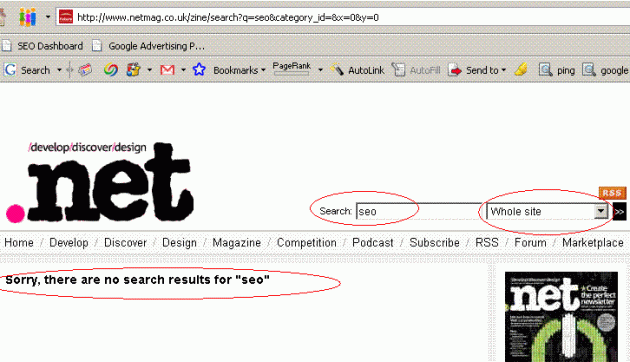I run Digg BigSpy on a plasma screen in my office, it gets regular attention and at least a dozen times a day inspires visits to Digg. A simple formula of scrolling text of varied size related to importance combined with witty title/headlines works well in driving much more traffic to Digg than would usually be seen from my team.
I ran Digg Big Spy screen saver in the background of a recent workshop for a large newspaper corporation. The screen constantly distracted the business focused activities (as intended) and nicely illustrated my point that the methods for delivering news can often eclipse the original publishers contribution, delivering the rewards to those who invested the least in the content offering. Value chain ethics aside, I love BigSpy and as long as it is outside of direct view it remains an asset rather than becoming a distracting liability.
In the case of BigSpy, the click through takes users to a Digg summary of the article, and only then does a click take users to the original publisher. The risk for publishers is that the brand value and editorial quality they invest in is being eroded by superficial browsing of stories, with no real loyalty to publications. There is no easy solution, as fighting social ratings/book marking or aggregation is a fast route to obscurity.
Another screen in my Search Team area displays Marumushi News Map which is either hated or loved by the various designers who pass by.
For content creators the key issues is neither BigSpy or News Map display the publisher, so by the time a click through has occurred, it was the size or headline catchyness that attracted the web user. Essentially Digg and Marumushi are abstracting users from publishers. Users are happy to swap guarantees of editorial quality for ease, speed of use and compelling UI that saves them roaming through several news homepages or blogs.
One of the core challenges for editorial organizations is that the creation of UI’s and aggregation is orders of magnitude cheaper and easier than the creation of high quality content. This can be seen in the plethora of new UIs and aggregates that surface each month compared to the static numbers of quality publishers like AP, Reuters, NYT, The Times, LA Times, BBC. There are a lot more bored programmers in Bay Area bedrooms than there are War Correspondents and Investigative journalists who will work for free.
But the ever present notion that the web will kill traditional newspapers or that citizen journalism can replace even the smallest area of true journalism will slowly make inroads to the business decisions of publishers and may start to erode the quality of content we have access to.
A well known senior search engine leader once told a ballroom full of newspaper editors that algorithms would make them obsolete. Apart from the irony of the comment, considering how many editorial teams this particular search engine employees , the risk is content creators may slowly reduce their investment levels in editorial.
While the web seems to offer an endless stream of content, a tiny amount of publishers generate the core value proposition around news, current affairs and investigative journalism. Take a story, such as Clark Rockefeller and spend an hour reading every available article and you slowly build up a picture of how few original sources of content there are. By my count, 11 sites authored 90% of all of the factual content I found, much of it from The Boston Herald who sent a reporter to Germany to investigate the story.
The financial investment required to create valuable news reporting means we may want to think twice before we abandon buying papers or believe content monitisation is solely the publishers problem, not ours. There is no reliable alternative to professional news and broadcast journalism, so undermining the editorial systems ability to pay for itself raises our risks of a less diverse or qualified media landscape.
I’ll just go and buy a few newspapers, but not until I look at that Digg about Kittens dressed as Stormtroopers…or the A Teams Top 10 crashes or the…
